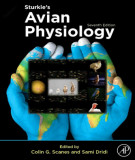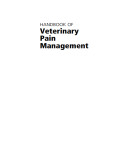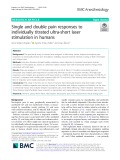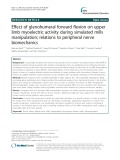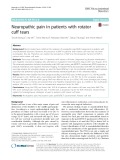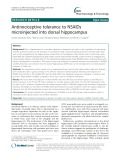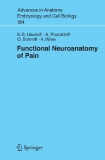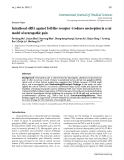
Nociceptive pain
-
Part 1 book "Sturkie's avian physiology" includes content: The importance of avian physiology; avian genomics; transcriptomic analysis of physiological systems; avian proteomics; avian metabolomics; mitochondrial physiology—sturkie's book chapter; evolution of birds; domestication of poultry; the avian somatosensory system - a comparative view; avian vision; avian hearing; chemesthesis and olfaction; taste in birds; avian nociception and pain,... and other contents.
 791p
791p  muasambanhan03
muasambanhan03
 02-01-2024
02-01-2024
 9
9
 2
2
 Download
Download
-
Part 1 book "Handbook of veterinary pain management" includes content: Pain management and the human animal bond, nociception and pain mechanisms, pain and stress, definitions of terms describing pain, assessing pain, health related quality of life measurement, overview of drugs administered to treat pain, nonsteroidal anti inflammatory drugs,... and other contents.
 273p
273p  oursky10
oursky10
 07-12-2023
07-12-2023
 5
5
 2
2
 Download
Download
-
This preclinical study in humans was designed to selectively induce delayed nociceptive pain responses to individually titrated laser stimulation, enabling separate bedside intensity scoring of both immediate and delayed pain.
 5p
5p  vampires36
vampires36
 30-12-2021
30-12-2021
 8
8
 0
0
 Download
Download
-
The Analgesia Nociception Index (ANI) has been suggested as a non-invasive guide for analgesia. Our objective was to compare the efficacy of ANI vs. standard pharmacokinetic pattern for guiding intraoperative fentanyl administration.
 8p
8p  vidietmarhopp
vidietmarhopp
 29-12-2021
29-12-2021
 6
6
 0
0
 Download
Download
-
Pain detection and treatment is a major challenge in the care of critically ill patients, rendered more complex by the need to take into consideration the risk of insufficient or excessive analgesia. The nociceptive flexion reflex threshold (NFRT) has become the established basis for measuring the level of analgesia in the perioperative context.
 13p
13p  vidietmarhopp
vidietmarhopp
 28-12-2021
28-12-2021
 5
5
 0
0
 Download
Download
-
It is generally accepted that muscles may activate via the common nociceptive flexion reflex (NFR) in response to painful stimuli associated with tensile or compressive forces on peripheral nerves.
 11p
11p  viannito2711
viannito2711
 20-04-2021
20-04-2021
 10
10
 1
1
 Download
Download
-
Recent studies have confirmed the existence of neuropathic pain (NeP) components in patients with musculoskeletal disorders. However, the presence of NeP in patients with rotator cuff tears has not been investigated thus far.
 6p
6p  vitennessee2711
vitennessee2711
 02-02-2021
02-02-2021
 12
12
 2
2
 Download
Download
-
Pain is characterized as a complex experience, dependent not only on the regulation of nociceptive sensory systems, but also on the activation of mechanisms that control emotional processes in limbic brain areas such as the amygdala and the hippocampus.
 8p
8p  vienzym2711
vienzym2711
 03-04-2020
03-04-2020
 12
12
 1
1
 Download
Download
-
Olvanil (NE 19550) is a non-pungent synthetic analogue of capsaicin, the natural pungent ingredient of capsicum which activates the transient receptor potential vanilloid type-1 (TRPV1) channel and was developed as a potential analgesic compound.
 11p
11p  vienzym2711
vienzym2711
 30-03-2020
30-03-2020
 10
10
 1
1
 Download
Download
-
Đau do cảm thụ (nociceptive pain) – Gây ra do kích thích các thụ thể cảm nhận đau còn nguyên vẹn. Đau do bệnh lý thần kinh (neuropathic pain) – Gây ra do sự tổn thương các dây thần kinh
 9p
9p  hoaihuong8983
hoaihuong8983
 28-05-2013
28-05-2013
 674
674
 59
59
 Download
Download
-
Pain is an unpleasant but very important biological signal for danger. Nociception is necessary for survival and maintaining the integrity of the organism in a potentially hostile environment. Pain is both a sensory experience and a perceptual metaphor for damage and it is activated by noxious stimuli that act on a complex pain sensory apparatus. However, chronic pain having no more a protective role can become a ruining disease itself, termed "neuropathic pain".
 126p
126p  mientrung102
mientrung102
 30-01-2013
30-01-2013
 44
44
 4
4
 Download
Download
-
The neurophysiology of cancer pain is complex: it involves inflammatory, neuropathic, ischaemic and compression mechanisms at multiple sites. A knowledge of these mechanisms and the ability to decide whether a pain is nociceptive, neuropathic, visceral or a combination of all three will lead to best practice in pain management. People with cancer can report the presence of several different anatomical sites of pain, which may be caused by the cancer, by treatment of cancer, by general debility or by concurrent disorders.
 0p
0p  khongmuonnghe
khongmuonnghe
 07-01-2013
07-01-2013
 46
46
 2
2
 Download
Download
-
Tuyển tập các báo cáo nghiên cứu khoa học ngành y học tạp chí Medical Sciences dành cho các bạn sinh viên ngành y tham khảo đề tài: Intrathecal siRNA against Toll-like receptor 4 reduces nociception in a rat model of neuropathic pain...
 9p
9p  thulanh9
thulanh9
 07-10-2011
07-10-2011
 39
39
 1
1
 Download
Download
-
Hội Chứng Đau Trong Bệnh Thần Kinh Bài này nói về Chứng Đau, trong Sách Thần Kinh Lâm Sàng do Bs Daniel Trương, Bs Lê Đức Hinh và Nguyễn Thị Hùng xuất bản năm 2004 (nhà xuất bản Y Học). Giới thiệu: Xuất phát từ tiếng Latin Poena, có nghĩa là sự trừng phạt, đau được định nghĩa là một trải nghiệm cảm giác và xúc cảm xuất phát từ tổn thương mô tiềm tàng hay tổn thương hiện tại. Đau được phân loại thành 3 loại chính như: 1) đau căn nguyên thần kinh, 2) đau tiếp nhận (nociceptive pain)...
 15p
15p  sinhtobo111
sinhtobo111
 13-04-2011
13-04-2011
 90
90
 3
3
 Download
Download
-
MRI of lumbar herniated disk; left S1 radiculopathy. Sagittal T1weighted image on the left with arrows outlining disk margins. Sagittal T2 image on the right reveals a protruding disk at the L5-S1 level (arrows), which displaces the central thecal sac. The mechanism by which intervertebral disk injury causes back pain is controversial. The inner annulus fibrosus and nucleus pulposus are normally devoid of innervation. Inflammation and production of proinflammatory cytokines within the protruding or ruptured disk may trigger or perpetuate back pain.
 5p
5p  ongxaemnumber1
ongxaemnumber1
 29-11-2010
29-11-2010
 72
72
 3
3
 Download
Download
-
Brainstem pathways that modulate sensory input. The key pathway for pain in migraine is the trigeminovascular input from the meningeal vessels, which passes through the trigeminal ganglion and synapses on second-order neurons in the trigeminocervical complex. These neurons in turn project in the quintothalamic tract and, after decussating in the brainstem, synapse on neurons in the thalamus. Important modulation of the trigeminovascular nociceptive input comes from the dorsal raphe nucleus, locus coeruleus, and nucleus raphe magnus.
 5p
5p  ongxaemnumber1
ongxaemnumber1
 26-11-2010
26-11-2010
 73
73
 2
2
 Download
Download
-
Pain transmission and modulatory pathways. A. Transmission system for nociceptive messages. Noxious stimuli activate the sensitive peripheral ending of the primary afferent nociceptor by the process of transduction. The message is then transmitted over the peripheral nerve to the spinal cord, where it synapses with cells of origin of the major ascending pain pathway, the spinothalamic tract. The message is relayed in the thalamus to the anterior cingulate (C), frontal insular (F), and somatosensory cortex (SS). B. Painmodulation network.
 5p
5p  ongxaemnumber1
ongxaemnumber1
 26-11-2010
26-11-2010
 73
73
 3
3
 Download
Download
CHỦ ĐỀ BẠN MUỐN TÌM








